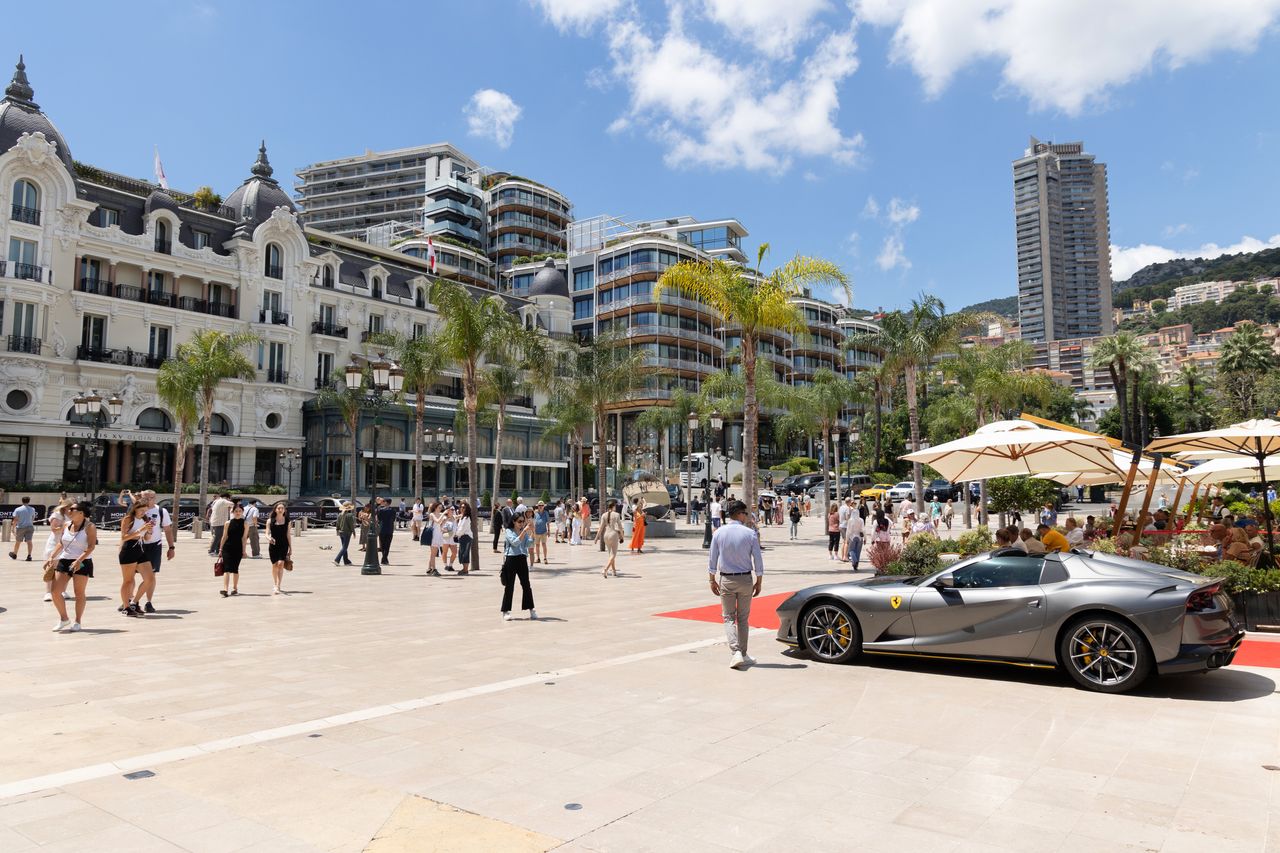It’s the Weirdest Time in History for Finance
What to know about bubbles in cryptos, meme stocks, and NFTs.
Two days after Halloween, there were more costumes than usual in New York’s Times Square. Outside Jimmy Buffett’s Margaritaville restaurant, one man wore a mirrored face shield and knit beanie to resemble a CryptoPunk pixelated character. A vehicle transformed to look like a cockroach made from junk played a slow-speed rap about “stacks of cash” to market a digital art gallery. A cowboy crooner in underpants, himself as familiar as a pretzel stand to regular passersby, had been commissioned by a man and woman in matching onesies to sing about their holographic worm.
This was NFT.NYC, a conference promoting nonfungible tokens, which signify ownership of digital assets and can be flipped by profit-seekers. The zaniness of the attendees felt strained, but that of their virtual source material can hardly be overstated. Finance the world over is weirder now than it has ever been. A decade of near-zero interest rates has fueled a bubble of bubbles across assets real and virtual. But not everything is overpriced, and savers needn’t despair or pile into fun-house speculations.
Step back for a moment from individual reports of wild price gains for odd things, and take in the scope of it all. Just this year, NFT auctions have ended with US$11.8 million paid for a CryptoPunk, $24.4 million for a collection of cartoon apes, and $69 million for a large assortment of drawings from a digital artist known as Beeple. These are not framed, one-of-a-kind pieces, but rather tokens proclaiming ownership of digital images that are copied freely across the internet.
That is nothing compared with cryptocurrency, an asset class younger than the iPhone. It is closing in on $3 trillion in market value, equal to about a quarter of the world’s mined gold, or the money supply of the United Kingdom. Dogecoin, a dog-themed, unlimited-supply parody crypto, is valued at $35 billion. It was eclipsed by Shiba Inu, a dog-themed parody of Dogecoin, which was worth $40 billion this past week—until it tumbled 20% on Thursday. In comparison, Hershey (ticker: HSY), the 127-year-old chocolate maker with operations in 85 countries, has a market value of $36 billion.
In meme stocks, GameStop (GME) and AMC Entertainment Holdings (AMC) at different points this year were up more than 20-fold. In special-purpose acquisition companies, or SPACs, Digital World Acquisition (DWAC) rose 15-fold after announcing that it would merge with Trump Media & Technology, whose best-known work is a slide deck of vague intentions to compete with Twitter, Facebook, Amazon.com, Apple, Walt Disney, and Netflix.
What can compare with all of this? Not Dutch tulips selling for as much as houses in the 17th century. That was a cosmopolitan folly, not, as was misreported many years later, a ruinous mania, as University of Southern California historian Anne Goldgar has shown. The South Sea bubble comes a bit closer, but it featured a stock that gained tenfold in 1720 and set off a rush of dubious new offerings, which is nothing that the trend-chasers on Reddit haven’t seen.
Dot-com stocks in the late 1990s? That was a frenzy, sure, but it was directionally correct, if a couple of decades early, before some of the best companies had blossomed. Japan in the 1980s? America’s Roaring ’20s? OK, those were doozies, and the economic aftermath was profound. But judging solely on weirdness, it’s unclear that credit-driven run-ups in stocks and real estate beat today’s run on virtual smiley faces, ironic stocks, and funny money.
This isn’t a valuation screed—not solely, at least. The world doesn’t need another asset-allocation traditionalist carrying on about Bitcoin not having cash flows. This is a hopeful note for ordinary savers and investors who no longer recognize their surroundings—who see abstract things selling for startling prices and wonder, on one hand, whether that’s dangerous for stocks, bonds, and traditional money, and, on the other, whether it’s too late to grab a stake in some new, fun, potential moon rocket.
Crypto assets don’t seem for now to present the sort of systemic risk that took down banks, or threatened to, during past crashes. “We could have another 1929 event, but the question is, who is it going to affect?” says Amy Lynch, a former financial regulator and founder of FrontLine Compliance, which advises money managers. “As long as the major financial players are actually not offering their own crypto exchanges and cryptocurrency trading platforms, then we are quote-unquote safe from the systemic risk.” To Lynch’s point, a fast-gaining cryptocurrency themed after the Netflix series Squid Game collapsed to zero this past week in an apparent swindle. Only its unlucky holders were harmed.
Last month, Mastercard (MA) said that it would make it easier for merchants and banks to offer crypto services. But it will do so at arm’s length. Newly listed Bakkt Holdings (BKKT) will handle the plumbing.
Strategists who disagree sharply on crypto can nonetheless agree that stocks still make sense. David Kelly, chief global strategist for J.P. Morgan Asset Management, calls crypto a “cult masquerading as a currency,” and attributes its gains and other rampant asset inflation to the world’s central banks. “They’ve no business keeping long-term interest rates this low for this long,” he says. But he’s not altogether put off by stocks at current valuations.
Kelly says the top 10 stocks in the S&P 500 index trade at about 30 times forward earnings estimates, which is “too high,” but that the rest of the index trades at 20 times, “and that’s OK given where interest rates are.” And he reckons that shares in the rest of the world are 30% cheaper than those in the U.S.
Liz Young, head of investment strategy at SoFi Technologies (SOFI), a provider of smartphone-centric financial services, including crypto trading through a partnership with Coinbase Global (COIN), says that stocks should always be part of a long-term growth portfolio. Bonds no longer offer enough downside protection to offset stock risk, so investors should consider adding alternatives, and that can include crypto, she says.
With 8,800 cryptocurrencies to choose among, she views a shakeout as possible. “You don’t really know that you’re in a bubble until after it bursts, right?” she says. “So, then we look back at it and say, ‘Oh, 8,800 coins was an indication, or this many SPACs and NFTs.’ ” But Young says she expects crypto to endure as an asset class.
Crypto’s ever-evolving technology is easier to make sense of than its pricing. Bitcoin was conceived as a store of value and payment system existing outside the purview of central banks, with limited supply. Ethereum, the No. 2 crypto, is these things, plus more of a platform for new products, like NFTs. Both are viewed by critics as restrictive and slow for everyday transactions, and it takes shocking amounts of electricity to create new coins.
Two other top-10 cryptos, Polkadot and Cardano, were created by Ethereum co-founders, and are designed to address these shortcomings. Polkadot founder Gavin Wood tells Barron’s that his ambition is to create a foundational technology for the world’s financial system. Jeff Pollack, chief financial officer at IOHK, the company behind Cardano, says he can envision poor countries that lack a robust banking infrastructure adopting decentralized finance to level the field.
Neither can fully explain what makes Polkadot, up 500% this year, worth $60 billion, or Cardano, up 1,000%, worth $68 billion, but that is a question for buyers, not builders. Both seem less than thrilled by the run-up in parody coins distracting from their work. “I do get kind of exasperated,” says Wood. Pollack says, “I don’t like the projects that delegitimize the legitimate projects.”
For nonfungible tokens, as with crypto, it’s unclear how potential usefulness relates to pricing. The technology could provide artists with new ways to make money from their work, and power trading in unique, virtual objects within videogames or other online worlds. Hot Wheels is launching NFT Garage, packs of virtual cars with random rareness that can be sold for crypto or cash. Dolce & Gabbana recently auctioned a nine-piece collection of garments and crowns intended for museum display, with corresponding NFTs—a “way for the metaverse and the universe to coexist,” it said.
Jefferies, the investment bank, expects NFTs to reach $25 billion in value in the “very near term.” The global market for physical collectibles is pegged at $370 billion.
Some investors in digital assets have developed novel ideas on risk. “If you talk to people in the crypto space, and you tell them that you’re 100% invested in Bitcoin, they think that you’re super-risk-averse,” observes SoFi’s Young. “It’s like the boomer coin.”
That isn’t far off from what we heard from Ranae Arnette, 33, who was in Times Square this past week to promote a prelaunch NFT marketplace called Snow Crash. Her personal portfolio consists of stock options for “daily plays” and cryptocurrency for long-term investment, but only a little Bitcoin. “It’s not going to give you the same return as if I were to invest in Shiba, which is like five decimals less than a penny,” she says.
Arnette was down $1,500 for the day, but had made $5,600 the day before, “so it doesn’t even feel like a loss,” she says. She learned about investing from podcasts and YouTube videos while stuck at home in the early days of the pandemic.
“I remember the first time that I opened my Robinhood app and I had made my paycheck in a day—in the first, like, 10 minutes of the stock market,” she says. “And I kind of just remember sitting at my desk at home with my computer in front of me, like, should I quit?” She went on to teach her mother, sister, brother, and friends to trade.
There is a temptation among seasoned investors to moralize about risk-taking in meme assets, and to expect a comeuppance at any moment for those who trade them. But another view is simply that digital natives have developed a way to monetize their ability to spot chat-room trends faster than the rest of us. It might be weird finance, but the same could be said of endless national budget deficits, years of negative real interest rates, and six-figure college degrees that lead to low-paying jobs.
And there is surely a path from meme-flipping to long-term savings.
This reporter, when in his early 20s, made a tidy little profit in a four-cent stock of such low quality that when it soared past $1, then died, one major newspaper called it “Nasdaq’s Billion Dollar Absurdity.” He didn’t turn to off-track betting or slots next. He backpacked through cheap countries until his winnings ran out, and has spent the decades since as a boring but content plunker of regular savings into the broad stock and bond markets.
And today, any promised comeuppance might take a while. J.P. Morgan’s Kelly expects only a gradual rise in interest rates, beginning late next year, with perhaps years more of silly asset pricing. FrontLine Compliance’s Lynch says that new regulations could dampen some of the excitement in crypto and bring down prices, but also that rule makers are “not going to move fast enough, I guarantee you that.”
What to do? Buy something preposterous, by all means. A bubble like this is not to be missed. But spend entertainment funds, not investment capital. And while tastes vary, consider not using terms like “correlation” to justify the purchase. Wall Street has always been prone to physics envy and over-mathematization, but in truth, it has only a rough idea of how stocks behave, and those are four centuries old. Let’s all agree to skip the regression analysis on five-year-old cryptocoins.
Don’t confuse a quick success with a strategy. When it came to momentum trading, even the author of the laws of physical momentum was no Newton, shall we say. Sir Isaac sold his South Sea holdings for a profit, and then jumped back in and took a bath. And don’t imagine that everyone else is getting rich from meme assets. Winners blab, and losers clam up, skewing perception.
Crypto dabblers should track tips on Twitter and the WallStreetBets forum on Reddit—buzz is everything for such assets. Crypto skeptics should brace for the angry mob when sharing their views. That is standard bubble stuff. For those who can’t decide whether to stick a toe in, there are always crypto-adjacent stocks with plenty of risk, like Coinbase, an exchange platform, and publicly traded companies that set computer rigs to work in “mining” digital coins: Marathon Digital Holdings (MARA), Riot Blockchain (RIOT), and Hut 8 Mining (HUT), to name a few.
Above all, keep return expectations low—both for crypto flings and for nest eggs invested in more mundane assets. BofA Securities estimates that the S&P 500, not counting dividends, is now priced for 0.5% annual price declines over the next decade. The 10-year Treasury yield is percentage points below the latest reading on inflation.
One place to search for good deals is within cyclical stock sectors. They can boom and fizzle, but tend to perform in line with the market over time, and now they are cheaper compared with the market than they have been 91% of the time since 1945, according to James Paulsen, chief investment strategist at The Leuthold Group. Think materials, industrials, financials, and consumer-discretionary stocks and exchange-traded funds.
BofA says reinvested dividends could make the difference between positive and negative returns over the next decade. Goldman Sachs expects S&P 500 payments to rise by 5% a year over that stretch. Boring? Consider: Regular cash payments to shareholders were the breakthrough that centuries ago allowed joint venture companies to begin operating in perpetuity, instead of dissolving after each trip to split the profits. Dividends gave rise to stocks, not the other way around. They are at least as innovative as ape NFTs. Buy iShares Core Dividend Growth ETF (DGRO), yielding just over 2%, and tell your friends you’re a fintech investor.
Resist financial nihilism. We suspect that stocks and even bonds will compare well with Shiba Inu long term, and we are confident they will outdo Squid Game crypto this quarter. But this era of easy gains in nearly everything is probably close to winding down.
Reprinted by permission of Barron’s. Copyright 2021 Dow Jones & Company. Inc. All Rights Reserved Worldwide. Original date of publication: November 6, 2021.
 Copyright 2020, Dow Jones & Company, Inc. All Rights Reserved Worldwide. LEARN MORE
Copyright 2020, Dow Jones & Company, Inc. All Rights Reserved Worldwide. LEARN MORE
This stylish family home combines a classic palette and finishes with a flexible floorplan
Just 55 minutes from Sydney, make this your creative getaway located in the majestic Hawkesbury region.
Continued stagflation and cost of living pressures are causing couples to think twice about starting a family, new data has revealed, with long term impacts expected
Australia is in the midst of a ‘baby recession’ with preliminary estimates showing the number of births in 2023 fell by more than four percent to the lowest level since 2006, according to KPMG. The consultancy firm says this reflects the impact of cost-of-living pressures on the feasibility of younger Australians starting a family.
KPMG estimates that 289,100 babies were born in 2023. This compares to 300,684 babies in 2022 and 309,996 in 2021, according to the Australian Bureau of Statistics (ABS). KPMG urban economist Terry Rawnsley said weak economic growth often leads to a reduced number of births. In 2023, ABS data shows gross domestic product (GDP) fell to 1.5 percent. Despite the population growing by 2.5 percent in 2023, GDP on a per capita basis went into negative territory, down one percent over the 12 months.
“Birth rates provide insight into long-term population growth as well as the current confidence of Australian families,” said Mr Rawnsley. “We haven’t seen such a sharp drop in births in Australia since the period of economic stagflation in the 1970s, which coincided with the initial widespread adoption of the contraceptive pill.”
Mr Rawnsley said many Australian couples delayed starting a family while the pandemic played out in 2020. The number of births fell from 305,832 in 2019 to 294,369 in 2020. Then in 2021, strong employment and vast amounts of stimulus money, along with high household savings due to lockdowns, gave couples better financial means to have a baby. This led to a rebound in births.
However, the re-opening of the global economy in 2022 led to soaring inflation. By the start of 2023, the Australian consumer price index (CPI) had risen to its highest level since 1990 at 7.8 percent per annum. By that stage, the Reserve Bank had already commenced an aggressive rate-hiking strategy to fight inflation and had raised the cash rate every month between May and December 2022.
Five more rate hikes during 2023 put further pressure on couples with mortgages and put the brakes on family formation. “This combination of the pandemic and rapid economic changes explains the spike and subsequent sharp decline in birth rates we have observed over the past four years,” Mr Rawnsley said.
The impact of high costs of living on couples’ decision to have a baby is highlighted in births data for the capital cities. KPMG estimates there were 60,860 births in Sydney in 2023, down 8.6 percent from 2019. There were 56,270 births in Melbourne, down 7.3 percent. In Perth, there were 25,020 births, down 6 percent, while in Brisbane there were 30,250 births, down 4.3 percent. Canberra was the only capital city where there was no fall in the number of births in 2023 compared to 2019.
“CPI growth in Canberra has been slightly subdued compared to that in other major cities, and the economic outlook has remained strong,” Mr Rawnsley said. “This means families have not been hurting as much as those in other capital cities, and in turn, we’ve seen a stabilisation of births in the ACT.”
This stylish family home combines a classic palette and finishes with a flexible floorplan
Just 55 minutes from Sydney, make this your creative getaway located in the majestic Hawkesbury region.






















